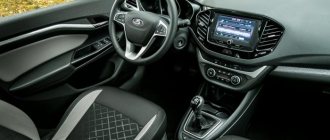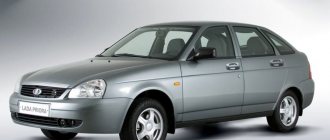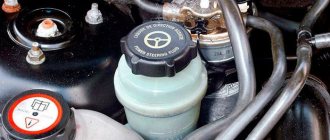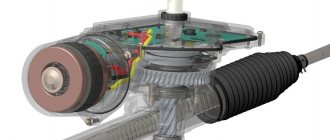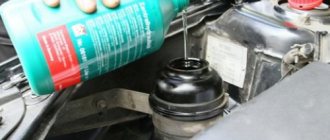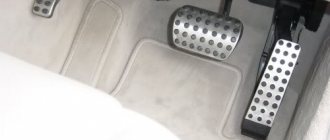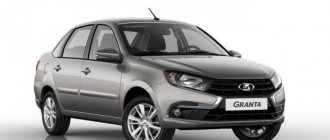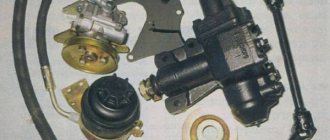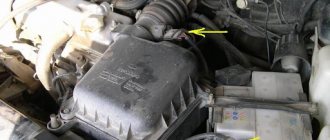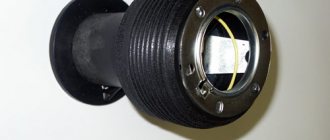If certain problems arise in the steering of your car, you should correct them immediately, otherwise delay may lead to the fact that the most important system of your car will malfunction and stop functioning normally. If it fails abruptly and directly while driving, then serious troubles in the form of loss of control and other not very successful consequences cannot be ruled out. A crunching sound when turning the steering wheel can mean several problems, each of which should be given special attention when diagnosing. Correcting it yourself or contacting a specialized service is up to you to decide. The car will definitely need good diagnostics, so the service in this case has many advantages.
A good service station will help you do a really good examination of each chassis and steering component in order to get reliable answers to the question of what caused the crunching noise. Turning the steering wheel affects more than just the steering rack. In this process, steering tips are included in the work, as well as rods that pull the elements of the chassis. Therefore, a knock or crunch in the steering wheel does not always mean problems with the steering mechanism. This may cause troubles associated with the chassis. Today we will look at the three most common problems that cause a crunching sound when turning the steering wheel.
CV joint is one of the likely culprits of steering wheel crunching
The steering mechanism does not often make sounds similar to a crunch, but for a CV joint this is the main indicator of a possible problem. Therefore, it is worth checking this particular breakdown first. If it crunches when turning while in motion, then in 90% of cases the culprit will be the CV joint, also called a grenade. This mechanism has a direct connection to the steering mechanism. When the steering wheel is turned to the maximum possible angle and a uniform, slow movement occurs when a grenade is broken, a crunching sound occurs, which intensifies over time. This problem can only be dealt with by replacement, which is quite difficult. The consequences of untimely repairs may be the following:
- gradual complete failure of the grenade and failure of this unit to perform its functions;
- When turning, the wheel begins to slip or slow down, depending on the nature of the breakdown;
- the crunch increases and no longer seems so harmless for the driver and passengers of the car;
- along with the crunching sound, a slight bouncing of the car appears when turning to the maximum degree;
- the thrust from the engine has every chance of simply flying out of the mount with the wheel, which will make further movement impossible;
- If a grenade suddenly falls out of its place, a load drop on the engine is possible.
You should not bring a breakdown to such a stage and check what can actually happen to the power unit. It is much better to simply eliminate the cause of the crunching and forget that such a problem was present. Few motorists have ever experienced what an overly neglected CV joint problem means, and reviews of this experience are not the most flattering. If, while turning, your car experiences a crunching sound in the steering area or on the wheels, you should simply replace the grenade with a new one. This is done at any service that services your brand of car.
Even a European car breaks down
You might think that all of the above-described malfunctions are characteristic exclusively of the Russian automotive industry. In fact, everything is completely different - even an expensive foreign car cannot be saved from breakdown. The whole point is also how often this will happen.
Currently, it can already be seen that the quality of the Russian automobile industry has improved significantly. For example, Renault Logan cars recently began to be produced in Russia - there are no problems with quality. To avoid suffering from car breakdowns, experts advise the following: you need to go for a full diagnosis at least once every month or two for the first six months, but there is no need to lead to symptoms (knocking, grinding and crackling noises).
Also, breakdowns largely occur due to poor-quality road surfaces. As you know, roads in Europe are much better than in Russia. For this reason, cars there are operated under more gentle conditions than here.
The steering rack has a peculiar crunch and appears infrequently
Some BMW models in the late 90s had a certain technical subtlety - their steering racks sometimes crunched. It’s not even a breakdown, it’s just that the rack had such a design feature. However, the Bavarians never had a good relationship with slats. But this node is not the only one that causes certain problems. Problems with the steering rack occur in almost all cars; this unit lasts no more than 250-300 thousand kilometers. With such a resource, almost every car has to deal with rack problems. Moreover, in some cases the mechanism can fail much faster. The main signs of a broken steering rack are:
- The crunch may occur during the entire stroke of the steering wheel or at certain intervals during rotation;
- knocks are heard not just under the hood of the car, but directly in the steering wheel, vibration is felt in the hands;
- with the engine turned off, when checking the free play of the steering wheel, a knock is heard in the extreme positions;
- the characteristics of the steering change, stiffness appears or, conversely, excessive ease in turning the steering wheel;
- There are problems in driving; the car does not always react to turning the steering wheel as expected.
If such problems exist in your car, you should work on the steering rack. Unfortunately, the design of the steering mechanism on modern cars is such that in most cases the rack will have to be replaced. This is an important point that should be applied almost always. Steering rack repair is short-lived, so it may not be economically viable and not very pleasant for further use. It is best to change the rack, and it may not be possible to do it yourself in a garage, especially on cars with power steering and other additions to the controls.
We determine which CV joint crunches, the inner or outer one
Several methods are used to diagnose CV joints. The simplest of them is a visual inspection of the anthers and checking the shafts.
The main cause of problems associated with the appearance of crunching is the ingress of dirt into the nodes, which can only occur due to damage to the boot.
If the rubber element is torn, then upon inspection there will be traces of leaking lubricant on it, from which you can understand which of the units got sand and dust.
Also, during inspection, you should try to move the drive shaft in the transverse and longitudinal directions by hand. CV joints are highly precision-manufactured units, and if it feels like they have play, it’s time to take action.
If, during a visual inspection, no leaks in the boot are detected, but symptoms of a joint malfunction appear, several simple methods can be used to identify which of the CV joints is problematic.
Chassis, bearings and other rare crunching options
When you check all the possible causes of the crunching noise when turning, you can safely say that the problem lies only in the chassis. Of course, finding chassis problems is quite difficult; for this, it is also better to use professional diagnostics. Crunching is the prerogative of bearings, but the only type of this element in the chassis that can crunch is the wheel bearing. However, they often buzz when they fail at a certain speed rather than crunch. If you want to diagnose wheel bearings, you can do it as follows:
- lift one side of the front of the car on a jack and secure the car well with stands;
- put the car on the handbrake, and also make sure that the three wheels are firmly on the base;
- sit behind the wheel or have your assistant sit down so that he performs certain actions to spin the wheel;
- after this you need to start the car, turn on second speed and smoothly release the clutch pedal, giving a little gas;
- Please note that such actions cannot be carried out on vehicles with all-wheel drive and a locked center differential;
- after this, you need to turn off the engine and allow the wheel to spin at a fairly high speed;
- if the bearing on this wheel is faulty, it will definitely tell you about it with an abundant hum;
- If the bearing is in good condition, only the sound of friction of the metal parts of the suspension will be heard.
This is a fairly simple way to diagnose wheel bearings and will not require too much time. To implement such a test, it is not necessary to have an assistant; you can carry out all the tests yourself. To do this, you need to quickly get out of the car while the wheel is spinning. The best noise from broken bearings is heard near the wheel. However, sometimes wheel bearings make a noise throughout the garage, then it’s better to replace them before it’s too late. Completely disintegrated wheel bearings will cause serious problems throughout the entire chassis. Therefore, it is worth paying special attention to correcting problems if any. We invite you to watch a short video describing the cause and elimination of the problem with knocking and crunching when turning the steering wheel:
Common causes of squeaking noise when turning the steering wheel
Here are the most common reasons why you hear a squeak when turning the steering wheel.
Wheel alignment performed incorrectly
If you hear squeaking noises from your tires, and it mostly happens when the car is stationary, there is a good chance that the problem is due to improper wheel alignment. In this case, it is necessary to perform a wheel alignment as quickly as possible to correct the problem.
Incorrect wheel alignment angles negatively affect the tires, which begin to wear unevenly and fail much faster than they should.
Silent blocks creak
A common problem that is often encountered in hot weather. If silent blocks begin to creak at high ambient temperatures, this is the first “bell” that they will soon fail.
The creaking of silent blocks in hot weather is due to their drying out. Since the main working material of silent blocks is rubber, at high temperatures it “dries out” and decreases in size, especially if we are talking about relatively old parts.
There is no danger in the creaking of silent blocks until the part breaks. Remove the silent blocks and carefully inspect them for cracks and various types of damage. If there are no visible problems, you can put them in place and continue driving, hoping that soon the air temperature will drop lower and the squeak will disappear.
Please note: For many modern cars you can find silent blocks made of polyurethane, which is not subject to the problem of “drying out” in the heat
Bearings squeak
If you hear a squeaking, squeaking, or crackling sound from the steering knuckle when you turn the steering wheel, this most likely indicates a bearing problem. They behave in a similar way if there is not enough lubrication for their proper operation or if there is sand (or other foreign element) in the bearing.
Bearing creaking must be eliminated as quickly as possible so that the part does not fail completely. To do this, remove the bearing and inspect it for damage. If they are not found, then lubricate the part, install it in place and adjust.
Please note: When a bearing squeak is caused by foreign elements getting into it, be sure to find the reason for them getting into the part
Steering rack or steering column creaks
It is quite simple to determine the creaking of the steering column by the characteristic vibration, which will also occur when the steering wheel rotates. Most often, the steering column clutch squeaks, and this problem is typical for cars that were unsuccessfully restored after a serious accident. This problem, if the noise is not strong, does not affect the quality of the steering mechanism, so you can continue to operate the car. The situation can only be corrected by replacing the steering column.
Also, a squeak can be heard from the steering rack and column joint if they are poorly adjusted or there is severe wear. Depending on the car model, this problem can be solved in different ways. Most often it is possible to adjust the mechanism.
Tie rod ends squeak
Due to damage to the anthers, foreign elements get into the tie rod end pin, which leads to squeaks both when turning the steering wheel and when overcoming obstacles. To determine if there is a problem, you need to inspect the tips, and if sand or other foreign matter actually got into them, you will need to replace them, and it is recommended to change them in pairs.
The plastic casing creaks
Every driver knows that when actively using a car that is not of the best build, “crickets” will appear over time. They represent creaks of the front panel, including the steering casing, made of plastic. This problem is solved in various ways, depending on the car model.
If all the parts described above have been inspected and the cause of the squeak cannot be determined, it is also recommended to check the power steering drive belt and brake elements, especially the pads and discs.
Let's sum it up
If you think that a crunching sound when turning the steering wheel is not such a serious problem, find out the opinions of those drivers who have encountered its consequences due to poor-quality repairs or no restoration at all. After a detailed study of the problem, it turns out that you are not getting the best operating conditions for the car, and if you wait and do not repair the car, you are even exposing yourself to a certain danger. It is best to immediately find the cause of the crunching and completely correct it.
In this case, we are often talking about the safety of the trip, so the best option would be to go to a professional service station and solve all problems by installing factory spare parts. A crunching sound always means that a specific control, chassis, or other components have broken down. Therefore, do not think that this manifestation will go away by itself. Just keep yourself safe and gain more confidence on every trip. What problems have you experienced that resulted in a crunching sound in the steering area?

